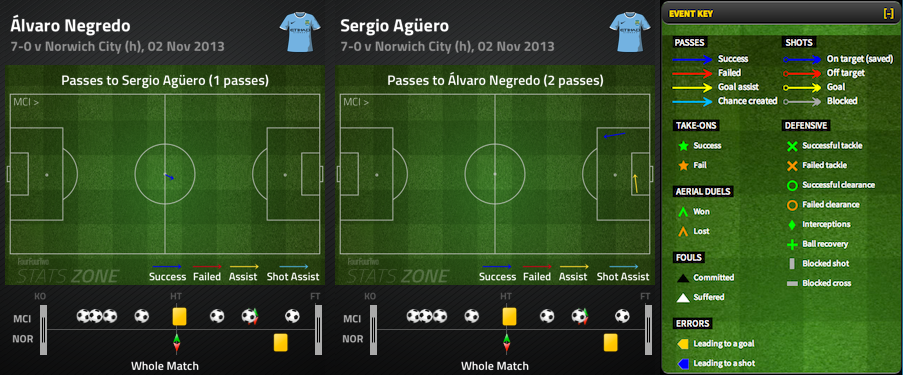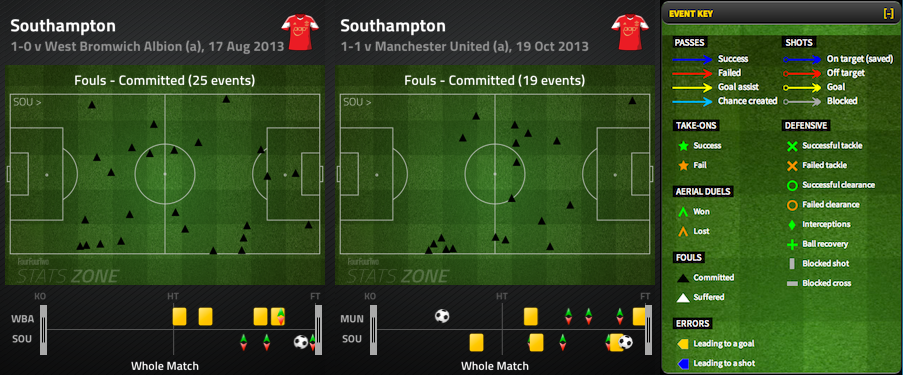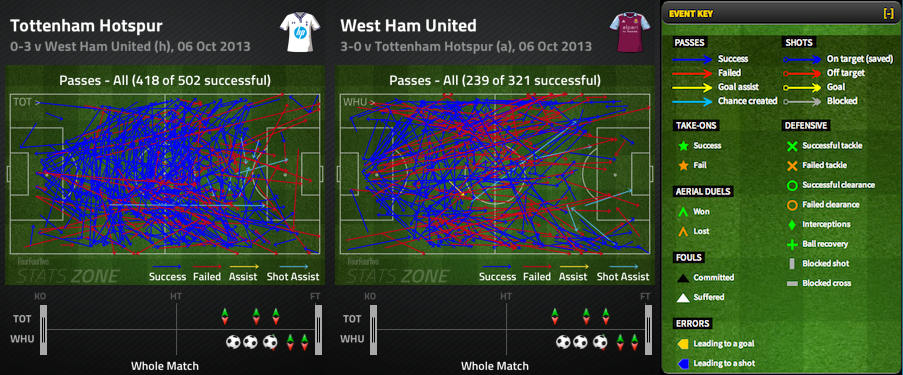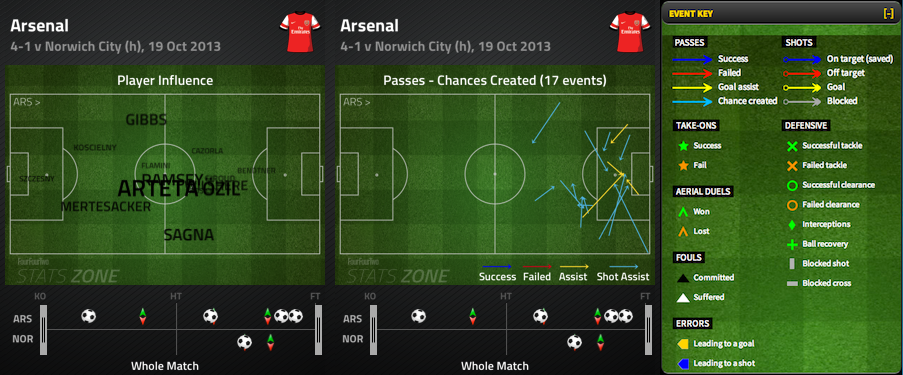What we've learned: Arsenal winging it, Saints have dirty secret & Nolan's a 'false nine'
Michael Cox lists the tactical trends of 2013/14

1. Two strikers up front remains an option for big clubs…
In a tactical sense, a defining feature of the Premier League season so far has been the popularity of two-striker formations at the top of the table – while Arsenal, Tottenham and Chelsea continue to use a lone striker, the other three title contenders are all using two up front.
Manchester United have played two strikers since the opening day, when Robin van Persie and Danny Welbeck both hit doubles. Wayne Rooney has re-established his position in the side, but the tone was set in that 4-1 win over Swansea, Moyes’ first league game in charge.

Liverpool have also thrived with two forwards – Luis Suarez missed the first six games of the season, but he and Daniel Sturridge have been banging in the goals since his return.

The strikers don’t even necessarily need to link up directly. Alvaro Negredo and Sergio Aguero were brilliant in the 7-0 thrashing of Norwich last weekend, but only combined three times, including once from the kick-off.

2. …and it can work for underdogs, too
A couple of years ago, it would have been unthinkable for an underdog to play two strikers against a side as creative and technical as Chelsea. Yet, in Newcastle’s 2-0 win over Jose Mourinho’s side, Alan Pardew did exactly that. By asking both Loic Remy and Shola Ameobi to drop back into a compact shape, preventing passes being played into Ramires and Frank Lampard, Newcastle successfully nullified Chelsea’s passing.
The best features, fun and footballing quizzes, straight to your inbox every week.

3. Whether dominating possession or playing on the break, you still need penetrative passes
One of the season’s most fascinating matches so far has been Manchester City’s trip to Stamford Bridge, where Fernando Torres’ late goal sealed a 2-1 victory for Chelsea. The sides had entirely different gameplans – Mourinho wanted counter-attacking whereas Pellegrini demanded ball retention.
However, once the ball was played into the final third, the approach was identical – both managers needed talented playmakers supplying Torres and Aguero with through-balls.

4. Fouling can be an effective means of defending
With just four goals conceded from their 10 matches, Mauricio Pochettino’s Southampton have the best defensive record in the Premier League, and the second best defensive record in Europe, behind Roma.
Pressing has been a key part of Southampton’s approach – and an interesting statistic is that Southampton have conceded more fouls than any other side, such is their determination to win possession quickly.
Their matches against West Brom and Manchester United were particularly interesting in this respect. Southampton foul high up the pitch, preventing the opposition from countering and allowing them to get men behind the ball. The location of the fouls also prevents punishment from the referee – despite committing the most fouls, Southampton have the third-best disciplinary record in the division.

5. You don’t need to dominate possession to have more shots
West Ham’s 3-0 win at White Hart Lane has been one of the more surprising results of the Premier League season so far. We’ve become accustomed to classic ‘smash and grab’ victories, where a side triumphs despite significantly fewer shots – Arsenal’s victory in Dortmund was a good example – but the interesting thing about West Ham’s win in North London was that they attempted more shots, despite managing only 39% of possession.
Andre Villas-Boas thought West Ham were fortunate to win, but can that be the case if they shot more frequently?


6. A three-man defence is workable
Wigan Athletic were the only side that regularly played a three-man defence in the Premier League last season, and their relegation was hardly a good advertisement for the use of the system.
However, Brendan Rodgers has used a 3-5-2 to some success this season – pushing Daniel Sturridge and Luis Suarez forward into centre-forward roles, keeping three men in midfield, and asking wing-backs to provide both defensive and offensive width. Liverpool haven’t kept a clean sheet with the formation, and last week’s defeat to Arsenal saw them switch to a back four at half-time, but the system certainly got the best out of Suarez and Sturridge.

7. Sides can keep clean sheets by defending high or deep
Southampton’s defensive success has been about their heavy pressing and their aggressive defensive line – they prevent the opposition from entering the opposition half by constructing a very high defensive block.
West Ham, however, have the joint-third best defence in the Premier League – and use the exact opposite approach, sitting very deep and soaking up pressure, concentrating on protecting their own penalty box. That variety makes for a fascinating contrast.

8. A lack of wingers doesn’t mean a lack of width
On paper, Arsenal should have struggled to penetrate opposition defences. The absence of Theo Walcott, Lukas Podolski and Alex Oxlade-Chamberlain robs them of their three direct wide players, and instead they’ve been forced to play five central midfielders strung across the pitch.
Somewhat surprisingly, Arsenal have been very successful at creating chances from wide positions. The attacking ability of Kieran Gibbs and Bacary Sagna, plus Mesut Ozil’s tendency to vary his position cleverly, means crossing has been a key feature of Arsenal’s season.

9. A side can improve their weakness while retaining their strength
It’s too early to decide whether Mark Hughes’ approach at Stoke will prove successful in terms of results, but he’s certainly adhered to the board’s request to improve the style of play – without compromising their aerial quality.
Stoke’s average share of possession has improved from 43% last season (17th in the league) to 48% this season (10th in the league) and their pass completion rate has risen from 70% (20th in the league) to 78% (14th in the league), yet they still win more aerial duels than any other side – demonstrated in their unfortunate defeat at Old Trafford.

10. Even long-ball sides can use a false nine
Sam Allardyce dislikes the use of the term ‘false nine’, but there’s little doubt Kevin Nolan – used up front in last weekend’s goalless draw against Aston Villa – is anything but a natural striker.
Nolan’s role was fascinating. Not only is a false nine generally found in a possession-orientated side rather than a long ball side, the West Ham captain is almost exclusively a goalscorer when used in a midfield role – barely creating any chances. When pushed upfront, he became the archetypal false nine, regularly creating chances for team-mates, but providing little goal threat.

